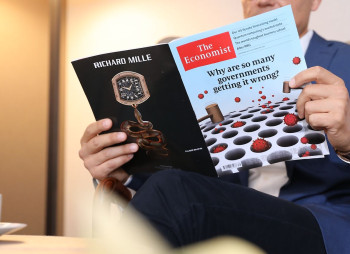Since February 2022, purchases of Ukrainian government bonds have reached a trillion hryvnias – or about $24.7 billion.
Bonds have been gaining popularity over the last five years, but during 2023, the total volumes increased 80 percent over just a year,” he said in a phone call.
Bonds are issued by governments to support spending and obligations. In return, the government pays coupon payments – periodic interest payments – usually once or twice a year.
But for Ukrainian investors, since Russia’s full-scale invasion, government bonds have become the ultimate bestseller. Why?
Limited variety of financial instruments in Ukraine
For starters, Ukraine’s financial market is somewhat limited for retail investors.
Bonds have gained popularity since 2016-2017, when Ukraine’s Ministry of Finance increased the volume of issued securities.
By 2021, they were considered a better alternative to bank deposits at local investment banks. Guaranteed by the government, they also had higher rates and lower risk.
The IMF unlocked another two-billion-dollar tranche for Ukraine, but decreased its main economic indicators in the forecast since Russia’s strikes on energy infrastructure are “devastating.”
Ukraine had a short period when retail investors could buy stocks through Alfa Bank (now Sense Bank), including Apple or Tesla stocks. But Russia’s invasion of Ukraine stopped that – the central bank imposed restrictions to prevent unproductive capital outflows caused by the shock of war.
REIT (Real Estate Investment Trust) funds and corporate bond investments have slowly become more popular since 2021, but the state doesn’t cover losses if investors choose these instruments.
There are also few companies and investment banks that offer them – Nova Poshta (through NovaPay company), UNIVER investment company, Inzhur fund are among the better known ones.
In any case, government bonds are one of the few low-risk, profitable investment vehicles.
Bonds became easier to buy and accessible to everyone starting at less than $30
Before 2022, investors could only buy bonds at Ukrainian banks. And the purchase cost of bonds was, no doubt, a barrier to entry – Investment Capital Ukraine (ICU) LLC for example, required a minimum investment of Hr.50,000 ($1,838 according to central bank’s dollar-hryvnia fx rate in 2021).
However, in February 2022, Ukraine found itself utilizing its entire budget on defending itself against the full-scale invasion of one of the largest armies in the world (with the exception of a tiny bit on loan interest rate compensation for businesses and a fraction for social spending).
This clearly demanded capital mobilization.
So the Ministry of Finance came up with a plan. They decided to issue government bonds that could be bought by any Ukrainian with a principal of less than $30 (1,000 hryvnia). And the bonds were made available for everyone through the country’s largest e-governance website, the Diia app.
After 2022, retail investors could buy bonds not just in banks but also directly through the app. And quite easily. Diia already had all the data about the future customers, making the purchasing process simple.
Bond buying counted as patriotic
With the war doubling government spending, bonds have been a great tool for Ukraine’s Ministry of Finance to allocate money toward its more-than-a-trillion-hryvnia budget deficit.
“War bonds are your contribution to Russia's defeat,” Ukraine’s Ministry of Finance said in its weekly news on bond purchase volumes.
The ICU – which is one of two key retail sellers of bonds – also puts patriotism at the foreground.
“By purchasing the bonds, you bring these territories closer to liberation [from Russia’s occupation],” the Diia website states.






